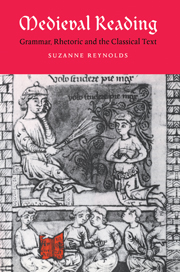Book contents
- Frontmatter
- Contents
- Acknowledgments
- Abbreviations
- 1 Introduction
- Part I CONTEXTS FOR READING
- Part II READING PRACTICE
- 4 Origins and mythologies: the invention of language and meaning
- 5 Reading word by word 1: the role of the vernacular
- 6 Reading word by word 2: grammatical and rhetorical approaches
- 7 From words to the phrase: the problem of syntax
- 8 Government: the theory and practice of a grammatical concept
- 9 Rival orders of syntax: vernacular, natural and artificial
- 10 From the phrase to the text: grammatical and rhetorical approaches again
- 11 Naked intention: satire and a new kind of literal reading
- 12 Literacy: a new model for the classical text in the Middle Ages?
- Notes
- Select bibliography
- General index
- Index of manuscripts
- Cambridge Studies in Medieval Literature
6 - Reading word by word 2: grammatical and rhetorical approaches
from Part II - READING PRACTICE
Published online by Cambridge University Press: 22 September 2009
- Frontmatter
- Contents
- Acknowledgments
- Abbreviations
- 1 Introduction
- Part I CONTEXTS FOR READING
- Part II READING PRACTICE
- 4 Origins and mythologies: the invention of language and meaning
- 5 Reading word by word 1: the role of the vernacular
- 6 Reading word by word 2: grammatical and rhetorical approaches
- 7 From words to the phrase: the problem of syntax
- 8 Government: the theory and practice of a grammatical concept
- 9 Rival orders of syntax: vernacular, natural and artificial
- 10 From the phrase to the text: grammatical and rhetorical approaches again
- 11 Naked intention: satire and a new kind of literal reading
- 12 Literacy: a new model for the classical text in the Middle Ages?
- Notes
- Select bibliography
- General index
- Index of manuscripts
- Cambridge Studies in Medieval Literature
Summary
In the last chapter, we plotted the ways in which the mother-tongue of the pueri structured pedagogical approaches to the individual words of a classical text. Translation (vernacular lexical) glosses provided a key for unlocking the treasure-trove of Latin vocabulary represented by Horace's Satires, while hic glosses were instrumental in conveying formal information about those same words. Both types of gloss raised complex issues about the interaction of vernacular structures with other models for analysing language – drawn principally from the lexicographic and grammatical traditions – and served as a warning that vernacular structures and glossing strategies are not necessarily equated. In this chapter, I want to develop this point by concentrating on word-based glosses whose form and function derive more directly from the tradition of Latin learning, from grammar and from rhetoric. In fact, Latin glosses constitute the vast majority of annotation in medieval manuscripts, but, largely on account of a scholarly tendency which locates the study of glosses in the history of language rather than in the history of reading, they are relatively rarely studied. However, if we are prepared to shift the ground, to move from a study of philology to a study of strategies, Latin glosses can reveal an enormous amount about reading and pedagogic practice. As we shall see, they are firmly grounded in the trivium arts of grammar and rhetoric, and demonstrate forcibly the need to see our form of medieval reading as one manifestation of a wider set of textual disciplines and concerns.
- Type
- Chapter
- Information
- Medieval ReadingGrammar, Rhetoric and the Classical Text, pp. 73 - 87Publisher: Cambridge University PressPrint publication year: 1996



